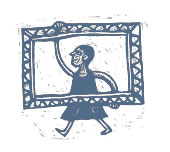Flamenco dancing was charged with sexual passion and melancholy, with the ‘duende’ of the south – “Nothing could be more antithetical to the Catalan character, or be more damaging to the severity and restraint of our race” (Josep Torras i Bages). Catalans should stick to their traditional ‘sardana’, a dance that expressed the social cooperation of the group, the village – Robert Hughes.






